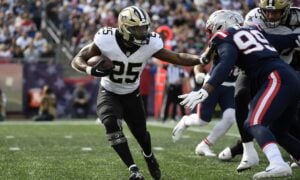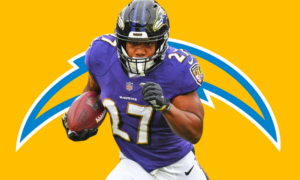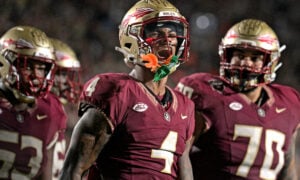Dynasty Capsule: Atlanta Falcons
Every year we give our premium content members a team-by-team, player-by-player look at the NFL season that was. The coverage will be in-depth, but because the Dynasty Capsule series begins immediately after the season, we won’t use it to discuss free agency or the draft. Come see us in early May once Mr. Irrelevant is off the board for another 32-article series giving you the same detailed discussion you’ll see below.
Buckle up dynasty fans, because you’re about to be reminded why our motto is, “There is no off-season.”
After two straight years in the playoffs, the Falcons finished at 7-9 in 2018, settling in for a longer than expected winter. Though largely competitive throughout (five of their nine losses were within ten points), Atlanta simply couldn’t get over the hump against quality competition, losing to every playoff team they faced. To that point, their best wins came over the similarly mediocre Redskins and Panthers, another pair of teams finishing at 7-9 as well.
Much of this drop-off can be explained by several key losses on the defensive side of the ball. To that point, Atlanta gave up the fifth-most yards and eighth-most points, functioning as a bottom-eight unit against both the run and the pass. The offense held up its end of the bargain, finishing sixth in yardage and tenth in points, but it wasn’t enough to mitigate the team’s defensive shortcomings.
Despite their record, the Falcons had numerous high-level performers in both real life and fantasy, and we’ll discuss them below.
Quarterback
[am4show have=’g1;’ guest_error=’sub_message’ user_error=’sub_message’ ]

Matt Ryan (ADP = 146.83; QB12)
Ryan quietly had an exemplary season, throwing for the second most yards and touchdowns of his career, while tying a career low in interceptions. His 8.1 YPA was also his second-best. He even managed to chip in an additional three scores on the ground.
Apart from a clunker against the league-best passing defense in Baltimore, Ryan also established a sound floor of 230-250 yards, and he threw at least one touchdown in every game but one. He had multiple scores in 11 games and showed a robust ceiling with eight 300+ yard outings. He took more sacks than owners would prefer (42), but it didn’t stop him from completing yet another 16-game season.
At only 33 years of age, it’s fair to posit Ryan isn’t getting a fair shake in the dynasty community. Over the past three years, he’s finished as the overall QB3, QB14, and QB3 again. For teams looking to upgrade at the position for a relatively cheap investment, it would be hard to do better than Ryan.
Matt Schaub (ADP = N/A)
Yup, he’s still in the league. No, you wouldn’t want to start him even if Ryan were to miss a game.
Running Back

Tevin Coleman (ADP = 68.5; RB28)
If you were to ask a Coleman owner prior to the season if he or she would be happy with a finish as the PPR RB18, they’d likely be ecstatic. And yet, given that starter Devonta Freeman missed essentially the entirety of the 2018 campaign, this result almost seems like a letdown. Sure, the efficiency was solid (4.8 YPC) and he was able to generate over 1,000 total yards, but for as explosive as the Atlanta offense was it’s easy to be disappointed.
Digging deeper, Coleman’s usage didn’t really change when Freeman went down. He received double-digit carries in ten of 16 games, but never exceeded 16 and only received 20 touches once. He had two 100+ rushing yard games and one more over 80, but was held below 60 yards a whopping 13 times. He showed well in the passing game, particularly as it related to finding the end zone, but scored the same number of touchdowns on the ground as Ito Smith despite nearly doubling him in carries. Despite compiling to the mid-level RB2 tier, you were more than likely receiving weekly RB3 output.
As an impending free agent, it’s hard to see Coleman remaining in Atlanta, especially with Freeman returning. Unfortunately, he didn’t appear to put enough on tape to convince another team to throw big money at him, and the 2019 crop of rookie ball carriers appears solid and deep, even if unspectacular. If Coleman finds a good home in free agency, you may want to consider selling prior to the NFL Draft.
Ito Smith (ADP = 176.7; RB62)
Unlike Coleman, Smith’s season could be considered more of a success. As a fourth-round rookie joining the club behind two entrenched ball carriers, expectations for anything more than a handful of touches were low. Instead, he was able to generate six games with ten or more touches, and converted four of his 90 carries into scores. His efficiency in the ground game was lacking, but he managed to catch 84.3% of his targets (though the subsequent output was also deprived of efficiency). All told, however, you could at least throw him into your lineup in a deeper league setting and have a non-negligible level of confidence he wouldn’t tank your lineup.
On the smaller side (5’9”, 195 lbs), Smith will have to rely on his speed, quickness and burst to find continuing success. He has the looks of a safe, albeit low-ceiling third-down back, though it wouldn’t surprise me if Atlanta looked for a bigger complement to Freeman in the NFL Draft. Given that you likely wouldn’t fetch more than a later round pick, however, he’s a solid stash.
Brian Hill (ADP = 240.3; RB97)
Squeaking into the very last running back slot in the DLF ADP, we know that at least Hill’s mom plays fantasy football! Sarcasm aside, Hill did well when called upon, even miraculously compiling a 100-yard game against the Panthers in a late-season Falcons win. However, he was still a distant third in the pecking order subsequent to Freeman’s injury, and did precious little outside of one big run. It’s notable that with Coleman’s seemingly impending departure, Hill is the only “big back” on the roster. He was also a workhorse in college, putting together two straight 1,600+ yard seasons, and has decent speed and burst for his size. He’s at least worth a look if you’re in a deep league.
Devonta Freeman (ADP = 52.8; RB23)
After succumbing to foot and groin injuries, Freeman was placed on Injured Reserve after appearing in only two games in 2018. Since then he’s been seemingly out of sight, out of mind, falling to the ADP ranks of a low-end RB2. This is despite the fact that prior to 2018 he had three straight seasons of at least 1,100 total yards, including two over 1,500. He has also excelled as the team’s goal-line back, with 29 rushing scores from 2015-2017.
It’s easy to get a bit squeamish about Freeman as he’s now been dinged up two years in a row and wasn’t the biggest guy (5’8”, 206 pounds) to begin with. However, he has the skill set to function in all facets of the game and should be returning healthy in 2019. With Coleman likely to move on, Freeman currently faces precious little in the way of competition. He might be one of the best buys in fantasy football for contending teams.
Jeremy Langford (ADP = N/A)
Mike Clay’s favorite player had a cup of coffee with the Falcons last year, but shouldn’t be rostered anywhere in fantasy football.
Wide Receiver

Julio Jones (ADP = 18.2; WR9)
Seemingly the only thing Jones has going against him is age. To that point, every receiver above him in the DLF ADP is at least four years his junior. Some things we can’t control and that includes the passage of time.
But what Jones can control is the way he dominates in a nearly unparalleled thorough and consistent basis. He posted the most receiving yards in the league in 2018, with over 100 more than the closest contender. He also tied for the third-most receptions, and after a slow start still tied for 11th in receiving scores. Only DeAndre Hopkins had more receiving first downs, besting him by one.
With 2018 in the books, Jones has compiled an absurd 524-7,994-31 line over the past five years, good for an average of 105 receptions, 1,599 yards and 6.2 touchdowns. His average weekly output in that span would be 18.9 points. He hasn’t had fewer than 1,400 yards in a season since an injury-ruined 2013. Simply remarkable.
I understand why Jones is where he is in the ADP hierarchy. The guys above him also range from very good to elite, and have theoretically more time available to owners. Dynasty football is a youth-driven culture, and that’s the one box Julio can’t check.
I know it’s a dangerous line of thinking, but when it comes to him slowing down, I’ll believe it when I see it. I understand there are numerous examples of older players unexpectedly falling off a cliff, most recently Dez Bryant and Demaryius Thomas. But Jones hasn’t yet lost a step, and we don’t have any reason to believe he can’t keep this up a few more years. He’s a guy I’ll be content to let retire on my roster if his ADP continues to fall despite elite production.
Calvin Ridley (ADP = 50.5; WR23)
Jones’ brilliance shouldn’t overshadow Ridley’s fine rookie season. Following a subpar NFL Combine where Ridley showed next to nothing outside of a solid 40-yard dash, doubters of the old-ish rookie began climbing out of the woodwork. Four games and six touchdowns later, the NFL freshman out of Alabama appeared to answer the bell.
It’s true he scored in bunches, and was quieter in that category for the majority of the middle of the season. Regardless, he tied for sixth in the league in receiving scores as a rookie; at that point, we should all become agnostic as to how it occurred, and care more about the fact it did occur. He also chipped in four games over 90 yards, showing a glimpse into his potential ceiling.
Yes, there were many games of 3-5 receptions and 30-50 scoreless yards, but that’s to be expected for a first-year player. More importantly, Ridley carved out a chunk of the offense for himself, despite the presence of two other quality receivers and an above-average tight end. I’d expect his receptions and yards to climb a bit at Sanu’s expense moving forward, with touchdowns likely regressing. A ceiling as a perennial PPR WR2 seems well within the range of outcomes.
Mohamed Sanu (ADP = 210.0; WR89)
Like a fine wine, Sanu appears to be getting better with age. Already the team’s best quarterback, the former Bengal took another step forward as a receiver in 2018, finishing second on the team in receptions and yards. His 12.7 YPR was his best total in his three years as a Falcon, as were his 838 yards.
Given the emergence of Ridley, improvement of Austin Hooper, and continued dominance of Jones, it’s more than reasonable to expect 2018 to function as Sanu’s high-water mark. With that said, a ranking as the WR89 per the ADP is the absolute height of disrespect. Sanu is a useful player who likely won’t tank you as a WR3 or FLEX on a weekly basis, and has a larger upside than many players above him. I’d happily test the waters with a third (or even fourth) round rookie pick to see if there are any takers.
Justin Hardy, Marvin Hall and Russell Gage (ADP = N/A)
With three solid fantasy options at the position ahead of them, none of these players are worth rostering outside of the deepest of leagues.
Tight End

Austin Hooper (ADP = 123.3; TE11)
In his third year in the league, Hooper took another step forward, establishing himself as a midrange PPR TE1. He set career highs in every meaningful category, while corralling an impressive 80.7% of his targets. Still only 24, it’s reasonable to question if the young tight end has begun to approach his ceiling.
Of course, his seasonal rank should be taken with a massive grain of salt, given the utter chaos at the position. Sure, TE6 sounds great in a vacuum, but Hooper was 100 points back of the top three 2018 options. In fact, only 30 points separated him from the TE12, showing the glut of mediocrity and lack of upside amongst this positional grouping.
We’ve also yet to see Hooper’s above average athleticism translate to the NFL field. Over the past two years, he’s been used as more of an extension of the run game, checking in at 9.9 YPR. There’s certainly value in that, but to truly move to the next echelon of players he’ll need to supplement that with more volume and a larger portion of the team’s red zone targets.
Hooper seems like a solid hold, and is priced appropriately. I wouldn’t go out of my way to buy him, and would be happy to include him as a bit piece in a larger deal. He appears to have a solid future as a mid-to-low end TE1, but not as a player who your opponents will fear seeing in your lineup.
Logan Paulsen and Eric Saubert (ADP = N/A)
Paulsen has kicked around the league for a few years now, failing to offer any discernible upside to date. I guess it’s pretty cool that he caught 100% of his targets and shares a name with Wolverine, at least. Saubert is a former small school fifth-round pick with athletic upside, who put together some nice numbers for the Drake Bulldogs. Per his ESPN profile picture, he also appears to be a well-coiffed young man.
Both belong on waivers, though Saubert may offer some intrigue over the next couple of years if he can put it together.
Follow me on Twitter @EDH_27
[/am4show]
- Dynasty Fantasy Football Mailbag: Is Kendre Miller Valued Unfairly? - April 17, 2024
- Forgotten Dynasty Veterans: Bottom Tier - April 9, 2024
- Dynasty Fantasy Football Mailbag: How Much Should You Factor in Off-Field Issues? - April 9, 2024


































































